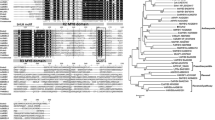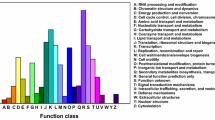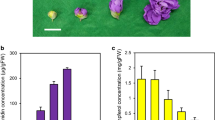Abstract
Flower color is an important economic trait of Prunus mume, a famous ornamental plant widely cultivated in East Asia. Anthocyanins, acting as major pigments of flower coloration, are biosynthesized via transcriptional regulation of transcription factors (TFs). Many R2R3-MYB TFs have been identified to regulate anthocyanin biosynthetic pathways. However, very little is known about the role of R2R3-MYB TFs regulating anthocyanin biosynthesis in P. mume. In our study, the first R2R3-MYB TF (PmMYBa1) from P. mume has been isolated and characterized. Sequence analysis revealed that PmMYBa1 contains conserved R2R3 MYB domain and belongs to anthocyanin-related subgroup 6 of R2R3-MYB family. Overexpression of PmMYBa1 in tobacco contributed to anthocyanin accumulation by activating endogenous anthocyanin-relating genes in the flowers and fruits of transgenic lines. Gene expression analysis showed that almost all of the endogenous structural genes of anthocyanin biosynthesis were obviously up-regulated, as well as bHLH TFs An1a and An1b in the flowers and fruits of PmMYBa1-overexpressing tobacco. In contrast, only three structural genes NtCHS, NtF3H, and NtANS were up-regulated in the leaves. In addition, the expression level of PmMYBa1 was higher in the anthocyanin-rich red flowers than in white ones and strongly correlated with anthocyanin content in the developing petals of P. mume. These findings strongly suggest that PmMYBa1 is involved in regulating anthocyanin biosynthesis in P. mume. Moreover, PmDFR and PmANS might be potential target genes regulated by PmMYBa1 in P. mume according to the correlation analysis. Isolation and functional characterization of PmMYBa1 laid a foundation for further exploring the mechanisms of anthocyanin synthesis and provide a potential candidate gene for breeding to manipulate flower colors in P. mume.







Similar content being viewed by others
Abbreviations
- CHS:
-
Chalcone synthase
- CHI:
-
Chalcone isomerase
- CaMV:
-
Cauliflower mosaic virus
- F3H:
-
Flavanone 3-hydroxylase
- DFR:
-
Dihydroflavonol 4-reductase
- ANS:
-
Anthocyanidin synthase
- UFGT UDP-glucose:
-
Flavonoid glucosyltransferase
- F3′H:
-
Flavanone 3′-hydroxylase
- F3′5′H:
-
Flavanone 3′5′-hydroxylase
- TAC:
-
Total anthocyanin content
References
Allan AC, Hellens RP, Laing WA (2008) MYB transcription factors that colour our fruit. Trends Plant Sci 13(3):99–102
Bai Y, Pattanaik S, Patra B, Werkman JR, Xie CH, Yuan L (2011) Flavonoid-related basic helix-loop-helix regulators, NtAn1a and NtAn1b, of tobacco have originated from two ancestors and are functionally active. Planta 234:363–375. doi:10.1007/s00425-011-1407-y
Ban Y, Honda C, Hatsuyama Y, Igarashi M, Bessho H, Moriguchi T (2007) Isolation and functional analysis of a MYB transcription factor gene that is a key regulator for the development of red coloration in apple skin. Plant Cell Physiol 48(7):958–970. doi:10.1093/pcp/pcm066
Borevitz JO, Xia Y, Blount J, Dixon RA, Lamb C (2000) Activation tagging identifies a conserved MYB regulator of phenylpropanoid biosynthesis. Plant Cell 12(12):2383–2394
Bovy A, de Vos R, Kemper M, Schijlen E, Almenar Pertejo M, Muir S, Collins G, Robinson S, Verhoeyen M, Hughes S, Santos Buelga C, van Tuinen A (2002) High-flavonol tomatoes resulting from the heterologous expression of the maize transcription factor genes LC and C1. Plant Cell 14:2509–2526. doi:10.1105/tpc.004218
Boyer J, Liu RH (2004) Apple phytochemicals and their health benefits. Nutr J 3:5
Chiu LW, Zhou X, Burke S, Wu X, Prior RL, Li L (2010) The purple cauliflower arises from activation of a MYB transcription factor. Plant Physiol 154:1470–1480. doi:10.1104/pp.110.164160
Cone KC, Burr FA, Burr B (1986) Molecular analysis of the maize anthocyanin regulatory locus C1. Proc Natl Acad Sci USA 83(24):9631–9635
Cone KC, Cocciolone SM, Burr FA, Burr B (1993) Maize anthocyanin regulatory gene pl is a duplicate of c1 that functions in the plant. Plant Cell 5(12):1795–1805. doi:10.1105/tpc.5.12.1795
Deluc L, Bogs J, Walker AR, Ferrier T, Decendit A, Merillon JM, Robinson SP, Barrieu F (2008) The transcription factor VvMYB5b contributes to the regulation of anthocyanin and proanthocyanidin biosynthesis in developing grape berries. Plant Physiol 147(4):2041–2053. doi:10.1104/pp.108.118919
Elomaa P, Uimari A, Mehto M, Albert VA, Laitinen RA, Teeri TH (2003) Activation of anthocyanin biosynthesis in Gerbera hybrid (Asteraceae) suggests conserved protein-protein and protein-promoter interactions between the anciently diverged monocots and eudicots. Plant Physiol 133(4):1831–1842. doi:10.1104/pp.103.026039
Espley RV, Hellens RP, Putterill J, Stevenson DE, Kutty-Amma S, Allan AC (2007) Red colouration in apple fruit is due to the activity of the MYB transcription factor, MdMYB10. Plant J 49:414–427. doi:10.1111/j.1365-313X.2006.02964.x
Fraser LG, Seal AG, Montefiori M, McGhie TK, Tsang GK, Datson PM, Hilario E, Marsh HE, Dunn JK, Hellens RP, Davies KM, McNeilage MA, Silva HND, Allan AC (2013) An R2R3 MYB transcription factor determines red petal colour in an Actinidia (kiwifruit) hybrid population. BMC Genom 14:28. doi:10.1186/1471-2164-14-28
Gonzalez A, Zhao M, Leavitt JM, Lloyd AM (2008) Regulation of the anthocyanin biosynthetic pathway by the TTG1/bHLH/Myb transcriptional complex in Arabidopsis seedlings. Plant J 53(5):814–827. doi:10.1111/j.1365-313X.2007.03373.x
Gu C, Liao L, Zhou H, Wang L, Deng X, Han Y (2015) Constitutive activation of an anthocyanin regulatory gene PcMYB10. 6 is related to red coloration in purple-foliage plum. PloS ONE 10(8):e0135159. doi:10.1371/journal.pone.0135159
Harborne JB, Williams CA (2000) Advances in flavonoid research since 1992. Phytochemistry 55:481–504
Hichri I, Barrieu F, Bogs J, Kappel C, Delrot S, Lauvergeat V (2011) Recent advances in the transcriptional regulation of the flavonoid biosynthetic pathway. J Exp Bot 62:2465–2483. doi:10.1093/jxb/erq442
Horsch R, Fry J, Hoffmann N, Eichholtz D, Rogers SG, Fraley R (1985) A simple and general method for transferring genes into plants. Science 227:1229–1231. doi:10.1126/science.227.4691.1229
Huang YJ, Song S, Allan AC, Liu XF, Yin XR, Xu CJ, Chen KS (2013) Differential activation of anthocyanin biosynthesis in Arabidopsis and tobacco over-expressing an R2R3 MYB from Chinese bayberry. Plant Cell Tissue Organ Cult 113:491–499. doi:10.1007/s11240-013-0291-5
Jin H, Cominelli E, Bailey P et al (2000) Trancriptional repression by AtMYB4 controls production of UV-protecting sunscreens in Arabidopsis. EMBO J 19:6150–6161. doi:10.1093/emboj/19.22.6150
Lai Y, Li H, Yamagishi M (2013) A review of target gene specificity of flavonoid R2R3-MYB transcription factors and a discussion of factors contributing to the target gene selectivity. Front Biol 8:577–598. doi:10.1007/s11515-013-1281-z
Larkin MA, Blackshields G, Brown NP, Chenna R, McGettigan PA, McWilliam H, Valentin F, Wallace IM, Wilm A, Lopez R, Thompson JD, Gibson TJ, Higgins DG (2007) Clustal W and Clustal X version 2.0. Bioinformatics 23:2947–2948. doi:10.1093/bioinformatics/btm404
Li C, Qiu J, Yang G, Huang S, Yin J (2016) Isolation and characterization of a R2R3-MYB transcription factor gene related to anthocyanin biosynthesis in the spathes of Anthurium andraeanum (Hort.). Plant Cell Rep 35(10):2151–2165. doi:10.1007/s00299-016-2025-8
Lin-Wang K, Bolitho K, Grafton K, Kortstee A, Karunairetnam S, McGhie TK, Espley RV, Hellens RP, Allan AC (2010) An R2R3 MYB transcription factor associated with regulation of the anthocyanin biosynthetic pathway in Rosaceae. BMC Plant Biol 10:50. doi:10.1186/1471-2229-10-50
Mehrtens F, Kranz H, Bednarek P, Weisshaar B (2005) The Arabidopsis transcription factor MYB12 is a flavonol-specific regulator of phenylpropanoid biosynthesis. Plant Physiol 138. doi:10.1104/pp.104.058032
Niu SS, Xu CJ, Zhang WS, Zhang B, Li X, Lin-Wang K et al (2010) Coordinated regulation of anthocyanin biosynthesis in Chinese bayberry (Myrica rubra) fruit by a R2R3 MYB transcription factor. Planta 231:887–899. doi:10.1007/s00425-009-1095-z
Pattanaik S, Kong Q, Zaitlin D, Werkman JR, Xie CH, Patra B, Yuan L (2010) Isolation and functional characterization of a floral tissue-specific R2R3 MYB regulator from tobacco. Planta 231:1061–1076
Petroni K, Tonelli C (2011) Recent advances on the regulation of anthocyanin synthesis in reproductive organs. Plant Sci 181:219–229. doi:10.1007/s00425-010-1108-y
Quattrocchio F, Wing JF, Leppen H, Mol J, Koes RE (1993) Regulatory genes controlling anthocyanin pigmentation are functionally conserved among plant species and have distinct sets of target genes. Plant Cell 5:1497–1512. doi:10.1105/tpc.5.11.1497
Quattrocchio F, Wing J, van der Woude K, Souer E, de Vetten N, Mol J, Koes R (1999) Molecular analysis of the anthocyanin2 gene of petunia and its role in the evolution of flower color. The Plant Cell 11:1433–1444
Rahim MA, Busatto N, Trainotti L (2014) Regulation of anthocyanin biosynthesis in peach fruits. Planta 240(5):913–929. doi: 10.1007/s00425-014-2078-2
Ramsay NA, Glover BJ (2005) MYB-bHLH-WD40 protein complex and the evolution of cellular diversity. Trends Plant Sci 10(2):63–70. doi:10.1016/j.tplants.2004.12.011
Sainz MB, Grotewold E, Chandler VL (1997) Evidence for direct activation of an anthocyanin promoter by the maize C1 Protein and comparison of DNA binding by related Myb domain proteins. Plant Cell 9:611–625. doi:10.1105/tpc.9.4.611
Schmittgen TD, Livak KJ (2008) Analyzing real-time PCR data by the comparative CT method. Nat Protoc 3:1101–1108
Shi JY, Gong JY, Liu JE, Wu XQ, Zhang Y (2009) Antioxidant capacity of extract from edible flowers of Prunus mume in China and its active components. LWT-Food Sci Technol 42:477–482
Stracke R, Werber M, Weisshaar B (2001) The R2R3-MYB gene family in Arabidopsis thaliana. Curr Opin Plant Biol 4(5):447–456
Takos AM, Jaffé FW, Jacob SR, Bogs J, Robinson SP, Walker AR (2006) Light-induced expression of a MYB gene regulates anthocyanin biosynthesis in red apples. Plant Physiol 142(3):1216–1232. doi:10.1104/pp.106.088104
Tamura K, Stecher G, Peterson D, Filipski A, Kumar S (2013) MEGA6: molecular evolutionary genetics analysis version 6.0. Mol Biol Evol 30(12):2725–2729. doi:10.1093/molbev/mst197
Tian J, Peng Z, Zhang J, Song TT, Wan HH, Zhang ML, Yao YC (2015) McMYB10 regulates coloration via activating McF3′H and later structural genes in ever-red leaf crabapple. Plant Biotechnol J 13:948–961. doi:10.1111/pbi.12331
Tohge T, Nishiyama Y, Hirai MY, Yano M, Nakajima JI et al (2005) Functional genomics by integrated analysis of metabolome and transcriptome of Arabidopsis plants over-expressing an MYB transcription factor. Plant J 42:218–235. doi:10.1111/j.1365-313X.2005.02371.x
Vimolmangkang S, Han Y, Wei G, Korban SS (2013) An apple MYB transcription factor, MdMYB3, is involved in regulation of anthocyanin biosynthesis and flower development. BMC Plant Biol 13:176. doi:10.1186/1471-2229-13-176
Walker AR, Lee E, Bogs J, McDavid DAJ, Thomas MR, Robinson SP (2007) White grapes arose through the mutation of two similar and adjacent regulatory genes. Plant J 49(5):772–785. doi:10.1111/j.1365-313X.2006.02997.x
Wang T, Hao RJ, Pan HT, Cheng TR, Zhang QX (2014) Selection of suitable reference genes for quantitative real-time polymerase chain Reaction in Prunus mume during flowering stages and under different abiotic stress conditions. J Am Soc Hortic Sci 139(2):113–122
Winkel-Shirley B (2001a) Flavonoid biosynthesis. A colorful model for genetics, biochemistry, cell biology, and biotechnology. Plant Physiol 126:485–493
Winkel-Shirley B (2001b) It takes a garden. How work on diverse plant species has contributed to an understanding of flavonoid metabolism. Plant Physiol 127:1399–1404
Xu W, Dubos C, Lepiniec L (2015) Transcriptional control of flavonoid biosynthesis by MYB-bHLH-WDR complexes. Trends Plant Sci 20:176–185. doi:10.1016/j.tplants.2014.12.001
Zhang Q, Chen W, Sun L, Zhao F, Huang B, Yang W, Tao Y, Wang J, Yuan Z, Fan G, Xing Z et al (2012) The genome of Prunus mume. Nat Commun 3:1318. doi:10.1038/ncomms2290
Zhao CL, Guo WM, Chen JY (2004) Research advances in the flower color of Prunus mume. J Beijing For Univ 26:123–127
Zhao J, Zhang W, Zhao Y, Gong X, Guo L, Zhu G, Wang X, Gong Z, Schumaker KS, Guo Y (2007) SAD2, an importin β-like protein, is required for UV-B response in Arabidopsis by mediating MYB4 nuclear trafficking. Plant Cell 19:3805–3818. doi:10.1105/tpc.106.048900
Zhou Y, Zhou H, Lin-Wang K et al (2014) Transcriptome analysis and transient transformation suggest an ancient duplicated MYB transcription factor as a candidate gene for leaf red coloration in peach. BMC Plant Biol 14(1):388. doi: 10.1186/s12870-014-0388-y
Zimmermann IM, Heim MA, Weisshaar B, Uhrig JF (2004) Comprehensive identification of Arabidopsis thaliana MYB transcription factors interacting with R/B like BHLH proteins. Plant J 40:22–34. doi:10.1111/j.1365-313X.2004.02183
Acknowledgements
This research was supported by Ministry of Science and Technology (2013AA102607), Special Fund for Beijing Common Construction Project, the Fund of Hebei province forestry scientific research projects (1404452).
Author contributions
QZ and QXZ designed the experiments. QZ performed experiments and wrote the manuscript. QZ, ZX, RH analyzed the data. QZ, WY, JW, TC, and HP revised the manuscript.
Author information
Authors and Affiliations
Corresponding author
Ethics declarations
Conflict of interest
The authors declare that they have no conflict of interest.
Additional information
Communicated by T. Winkelmann.
Electronic supplementary material
Below is the link to the electronic supplementary material.
Rights and permissions
About this article
Cite this article
Zhang, Q., Hao, R., Xu, Z. et al. Isolation and functional characterization of a R2R3-MYB regulator of Prunus mume anthocyanin biosynthetic pathway. Plant Cell Tiss Organ Cult 131, 417–429 (2017). https://doi.org/10.1007/s11240-017-1294-4
Received:
Accepted:
Published:
Issue Date:
DOI: https://doi.org/10.1007/s11240-017-1294-4




